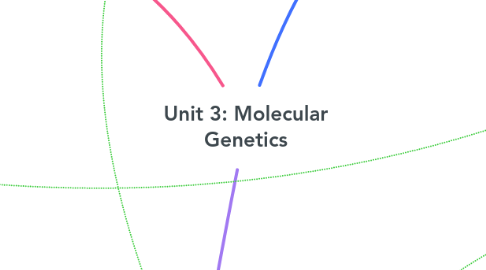
1. DNA contains all the genetic information for any living organism
1.1. Cells use instructions written in DNA to make proteins.
1.1.1. Cell will activate the gene to code for a certain protein. There are around 25,000 genes and each gene codes for 1 protein.
1.1.1.1. Due to mutations in DNA, cancer may develop, but it may also result in resistance built against certain environmental factors.
1.2. Single/Double stranded DNA
1.2.1. Single-stranded DNA: nucleotides are bonded by phosphodiester bonds by a dehydration/condensation reaction.
1.2.2. Double-stranded DNA: 2 DNA strands are linked by hydrogen bonds between complimentary nitrogenous bases
1.3. DNA Replication
1.3.1. 1. Strands are separated. The helicase enzyme unzips the strand by breaking hydrogen bonds, creating the replication fork. This happens until a daughter strand is copied from the template strand.
1.3.1.1. 2. Complimentary strands are built. Leading strand is one continuous strand that is built toward the replication fork, while the lagging strand is built in pieces away from the replication fork and is joined by an enzyme when completed. Now, an RNA primer is added across from a 3' nucleotide to start DNA synthesis. Then DNA polymerase III will add nucleotides from the 3' end. DNA polymerase I replaces every RNA nucleotide U with the DNA nucleotide T on the daughter strand. As the lagging end is built in pieces (called Okazaki fragments), DNA ligase joins them together to make one long daughter strand.
1.3.1.1.1. 3. Lastly, errors during replication is checked. DNA polymerase III detects for incorrect nucleotide pairing. If there is an error, it will stop to replace the nucleotide. If the DNA polymerase III misses a mistake or if there are other errors in the DNA elsewhere, the repair complex enzymes will correct the error. It will remove the error and rebuild the section.
2. Genetic research and biotechnology have social, legal, and ethical implications
2.1. The study of genetics is done to understand the characteristics of groups of people, which could result in steretyping or generalizations of groups of people
2.1.1. Cancer: cell sequences are mutation to form oncogene. Cell division happens really quickly which results in unspecialized cells, thus causing tumors.
2.2. Insurance companies who have a record of an individual's genetic tests may discriminate against them if they had a genetic disease
2.2.1. Similarly, during IVF, embryo selection chooses "better" babies with the best genetics
2.3. Designer babies: A genetically altered baby with genes that are catered to the parent's needs/wants
2.3.1. Can avoid genetic diseases but is also ethically wrong to change a baby's genetic makeup according to what parents want (smarter genes, height, eye color, hair color, etc...)
3. Proteins control a wide variety of cellular processes
3.1. Proteins are made of many amino acids that are arranged in different ways/shapes for different functions. The sequence and qualtity of amino acids matter as well.
3.2. Protein synthesis: process of making proteins
3.2.1. Transcription +translation
3.2.1.1. Transcription: DNA info is copied to an RNA (rewritten). Happens in nucleus. Happens in 3 stages: initiation, elongation, and termination.
3.2.1.1.1. Initiation: RNA polymerase binds + unwinds DNA at promoter
3.2.1.1.2. After the 3 stages, modifications are made so that the pre-mRNA can survive cytosol conditions.
3.2.1.2. Translation: RNA is turned into amino acids of a certain protein. Happens in the cytosol. # steps in translation: initiation, elongation, and termination
3.2.1.2.1. Initiation: tRNA with anticodon UAC and start codon AUG makes a complex with a small ribosomal subunit on the peptidyl site. It will then bind to the 5' cap of mRNA and scan until a start codon is found.
3.2.2. Different proteins have different functions, but they generally regulate the cell by: controlling flow of info/contents, controlling cell division, trasmitting signals, providing structure to cells, and more.
